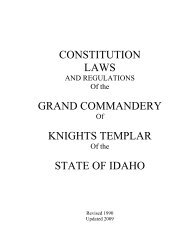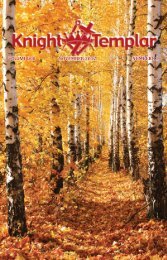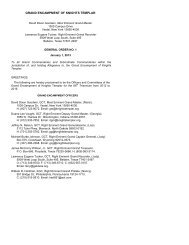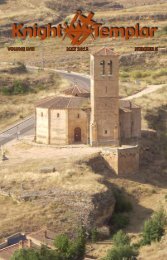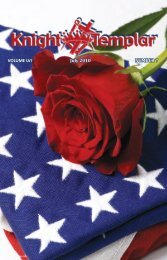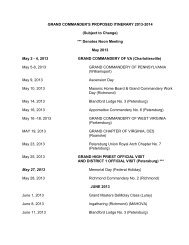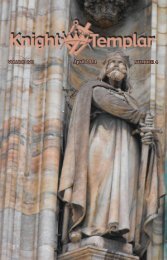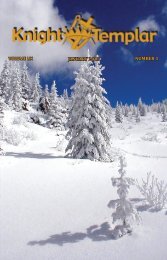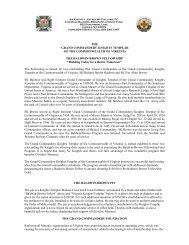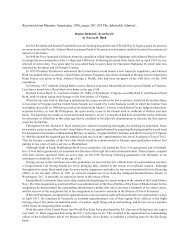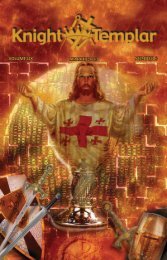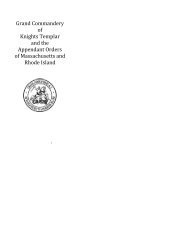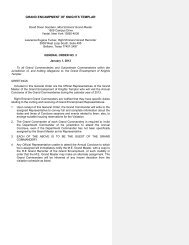MAY - Grand Encampment of Knights Templar, USA
MAY - Grand Encampment of Knights Templar, USA
MAY - Grand Encampment of Knights Templar, USA
Create successful ePaper yourself
Turn your PDF publications into a flip-book with our unique Google optimized e-Paper software.
The crossbones also have an intriguing<br />
Masonic application. In the guidelines<br />
provided by the <strong>Grand</strong> Lodge <strong>of</strong><br />
Colorado for implementing and conducting<br />
a proper chamber <strong>of</strong> reflection, Masons<br />
are informed that “[t]he crossbones<br />
are also a hint at the pillars, the portico<br />
<strong>of</strong> man upon which he must stand as<br />
he labors in the quarry.” 6 As Matthew C.<br />
Pelham, Sr. demonstrated in his thought<br />
provoking article “A Search for More<br />
Light in the Symbolism <strong>of</strong> the Skull and<br />
Crossbones,” the association between<br />
the crossbones, which themselves are<br />
always constructed using human femurs<br />
or thighbones, and the two pillars <strong>of</strong> the<br />
Temple, stems no doubt from the verse<br />
in Song <strong>of</strong> Solomon which announces in<br />
a moving hymn to Deity that “His legs<br />
are as pillars.” 7 Still, there is another<br />
similarity between the pillars <strong>of</strong> the Masonic<br />
Lodge and someone’s (or, more<br />
specifically, something’s) legs which is<br />
so absolutely striking that I dare not fail<br />
to mention it.<br />
In the Greek myth <strong>of</strong> Jason and the<br />
Argonauts, the ship Argo sailed to Europa<br />
in Crete following Jason’s legendary<br />
retrieval <strong>of</strong> the golden fleece. On the island<br />
<strong>of</strong> Europa, the Argonauts encountered<br />
a great metallic giant called Talos,<br />
meaning sun or solar, which was cast<br />
wholly <strong>of</strong> solid bronze. His legs, on the<br />
other hand, while also made <strong>of</strong> bronze,<br />
were cast completely hollow, and one <strong>of</strong><br />
them, it was said, contained a single vein<br />
through which flowed the divine ichor or<br />
golden blood <strong>of</strong> the gods. The presence<br />
<strong>of</strong> the ichor within his leg animated the<br />
giant, enabling Talos to perform the sole<br />
function for which he was created, that<br />
is to circumambulate Europa three times<br />
daily in order to protect and guard the<br />
land from approaching pirates. If the<br />
knight templar<br />
reader will recall, the Pillars <strong>of</strong> Freemasonry<br />
are also said not only to have been<br />
hollow and cast from bronze, but according<br />
to some traditions within the Craft, it<br />
was only one <strong>of</strong> them which contained<br />
the treasured archives <strong>of</strong> Freemasonry,<br />
not unlike Talos’ peculiar legs, only one<br />
<strong>of</strong> which was possessive <strong>of</strong> the Olympic<br />
gods’ magical ichor. Lastly, it is notable<br />
that scholar A. B. Cook interpreted the<br />
myth <strong>of</strong> Talos as being a veiled allusion<br />
to the Masonically relevant lost wax<br />
casting method <strong>of</strong> metallurgy thus bringing<br />
us back full circle to the question <strong>of</strong><br />
the legitimacy <strong>of</strong> this symbol.<br />
Regardless <strong>of</strong> the negative connotations<br />
which may surround the image,<br />
the symbol <strong>of</strong> the skull and crossbones,<br />
whether considered exoterically or<br />
esoterically, is absolutely possessive <strong>of</strong><br />
pr<strong>of</strong>ound Masonic import. As we have<br />
demonstrated, the image is suggestive<br />
<strong>of</strong> both man’s mortality and more significantly,<br />
initiation within the Masonic<br />
Lodge. We are hopeful that we’ve aided<br />
our more uncertain Brethren in laying<br />
aside some <strong>of</strong> their underlying fears and<br />
insecurities concerning this most curious<br />
and potent <strong>of</strong> Masonic emblems.<br />
The symbol <strong>of</strong> the skull and crossbones<br />
points at once to the inevitable end <strong>of</strong><br />
man as well as to one <strong>of</strong> the means by<br />
which he might accept and come to<br />
peace with the knowledge and anticipation<br />
<strong>of</strong> such an ending, tried and true<br />
Masonic initiation.<br />
End Notes<br />
1<br />
Meaning “Remember Death”<br />
2<br />
Folger Ms. 1<br />
3<br />
Samuel Pritchard’s Masonry Dissected (1730)<br />
4<br />
Tobias Churton’s The Golden Guilders: Alchemists,<br />
Rosicrucians, and the First Freemasons,<br />
p. 222<br />
5<br />
Song <strong>of</strong> Solomon 5:15<br />
25




